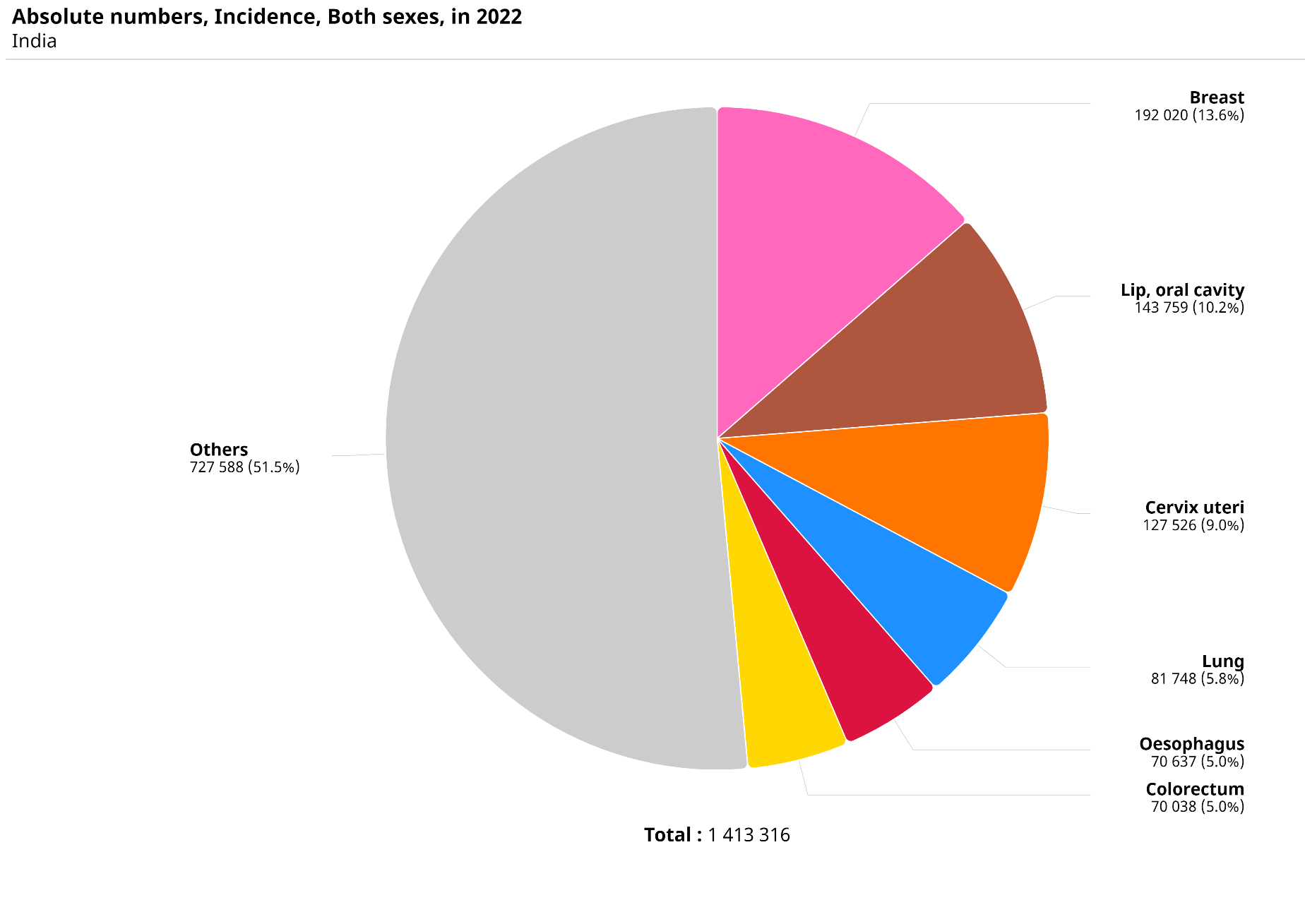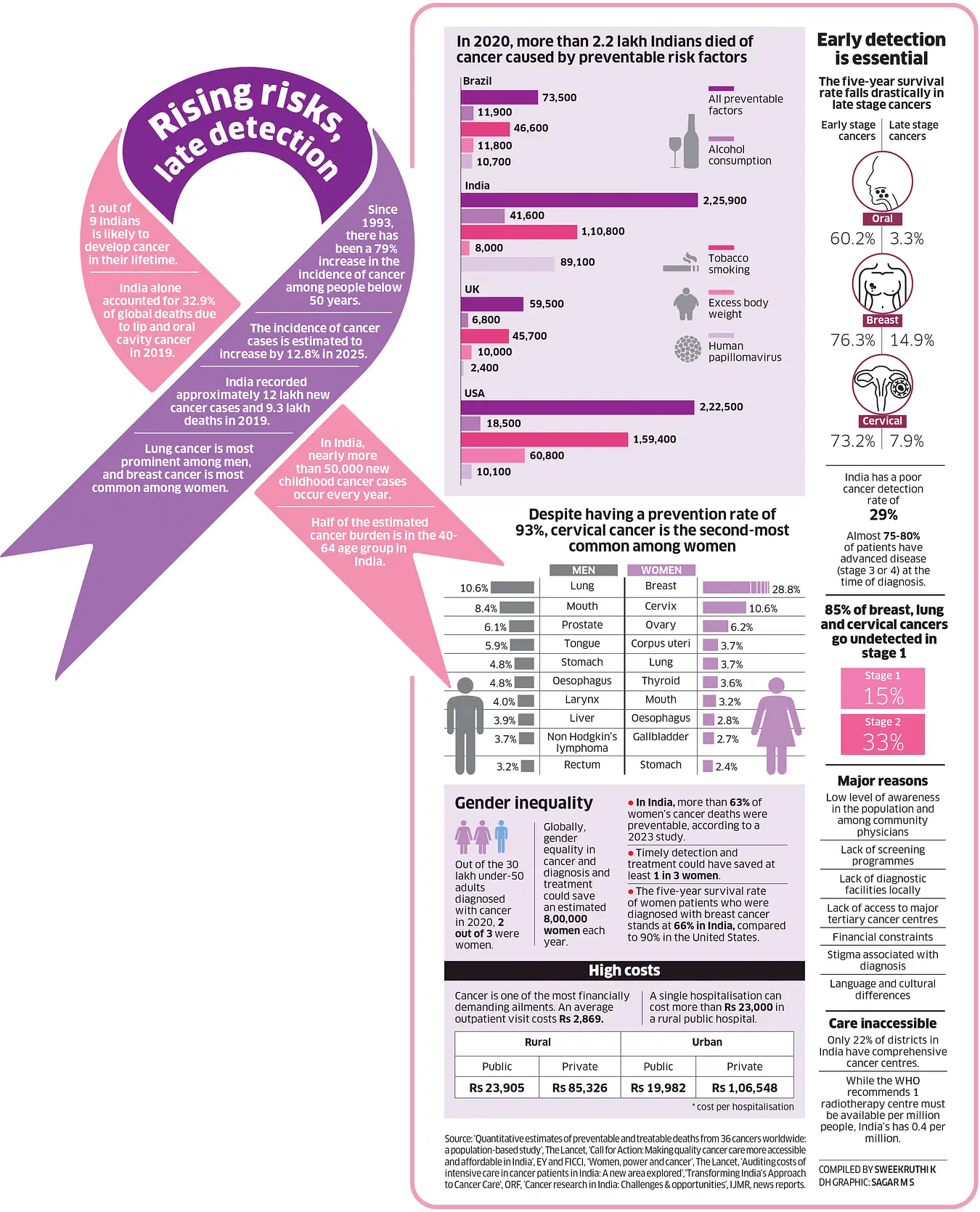Social Issues
Rising Cancer Concerns
- 20 Aug 2024
- 10 min read
For Prelims: Cancer, Global Burden of Cancer, World Health Organisation (WHO)
For Mains: Issues relating to the development and management of Social Sector/Services relating to Health, Education, Rising Cases of Different forms of Cancer in India and its impact on the Health Sector.
Why in News?
A recent study published in the journal Cancer predicts that global cancer cases in men will increase by 84.3% and the number of cancer deaths will increase by 93.2% by 2050 compared to the 2022 estimate.
- This alarming trend underscores a significant public health challenge that requires urgent attention.
What are the Key Findings of the Study?
- Projected Increase in Cancer Cases and Deaths: The study predicts that cancer cases among men will rise to 19 million by 2050 while cancer deaths are expected to reach 10.5 million.
- Projection of Specific Cancer Types: From 2022 to 2050, mesothelioma (the most common kind of lung cancer) cases are expected to increase by 105.5%, prostate cancer deaths by 136.4%, while testicular cancer will see the smallest rises, with incidents up by 22.7% and deaths by 40%.
- Dominance of Lung Cancer: Lung cancer is expected to remain the leading type of cancer in both incidence and mortality, with a projected increase of over 87% compared to 2022.
- Disparities Across Age and Regions: The report notes significant disparities in cancer rates by age and region, with about 10.3 million cases and 5.4 million deaths among men globally in 2022.
- Nearly two-thirds of these cases were in adults aged 65 and older.
- Impact of Human Development Index (HDI): The report predicts that cancer cases will increase by 50.2% in very high HDI countries and by 138.6% in low HDI countries from 2022 to 2050.
- Cancer deaths are expected to rise by 63.9% in very high HDI countries and 141.6% in low HDI countries.
- High Mortality-to-Incidence Ratios: The report highlights high mortality-to-incidence ratios, with older men at 61% and low HDI countries at 74%. Rare cancers like pancreatic cancer have an even higher ratio of 91%, indicating poor survival outcomes.
- The Mortality-to-Incidence Ratio (MIR) is a measure that compares the number of cancer deaths (mortality) to the number of new cancer cases (incidence) over a specified period.
What is the State of Cancer Prevalence in India?
- India reported 1,413,316 new cases in 2022 with a higher proportion of female patients (691,178 men and 722,138 women).
- Breast cancer had the highest proportion in the country, with 192,020 new cases, accounting for 13.6% of all patients and over 26% in women.
- In India, breast cancer was followed by lip and oral cavity (143,759 new cases, 10.2%), cervix and uterine, lung, and esophageal cancers.
- A recent study by WHO assessing the cancer burden in Asia, published in The Lancet Regional Health, found that India alone accounted for 32.9% of global deaths and 28.1% of new cases of lip and oral cavity cancer in 2019.
- This was on account of the widespread consumption of smokeless tobacco (SMT) such as khaini, gutkha, betel quid and paan masala in South Asian countries like India, Bangladesh and Nepal.
- Worldwide, SMT is responsible for 50% of the oral cancer burden.
- As per the Lancet Global Health 2023, India accounted for 23% of deaths that occurred due to cervical cancer globally.
- In India, cervical cancer’s five-year survival rate was 51.7% which is lower compared to high-income countries such as the United States.
Cancer
- It is a complex and broad term used to describe a group of diseases characterised by the uncontrolled growth and spread of abnormal cells in the body.
- These abnormal cells, known as cancer cells, have the ability to invade and destroy healthy tissues and organs.
- In a healthy body, cells grow, divide, and die in a regulated manner, allowing for the normal functioning of tissues and organs.
- However, in the case of cancer, certain genetic mutations or abnormalities disrupt this normal cell cycle, causing cells to divide and grow uncontrollably.
What are the Government Initiatives for Cancer Control In India?
- In the Union Budget 2024-25, the government exempted 3 cancer medicines- Trastuzumab Deruxtecan, Osimertinib, and Durvalumab from customs duty.
- The Interim Budget 2024-25 encouraged the vaccination of girls aged 9-14 years to prevent cervical cancer.
- National Programme for Prevention and Control of Cancer, Diabetes, Cardiovascular Diseases and Stroke
- National Cancer Grid
- National Cancer Awareness Day
- HPV Vaccine
- Ayushman Bharat- Health & Wellness Centres (AB-HWCs)
What are the Key Highlights of the NITI Aayog Report on Early Cancer Detection in India?
- Cancer Screening Gap: According to NITI Ayog’s Report, there is a significant shortfall in cancer screening at Ayushman Bharat Health and Wellness Centres (HWCs).
- Less than 10% of these centres had conducted even a single round of screening for non-communicable diseases, including cancer.
- Screening Practices:
- Breast Cancer: Screening is performed via self-examination.
- Cervical Cancer: Screening has not been fully implemented.
- Oral Cancer: Screening is conducted on a case-by-case basis, depending on visible symptoms.
- Infrastructure and Resources: HWCs lacked basic infrastructure, devices, medicines, and diagnostic tests as per operational guidelines.
- Staff Training and Awareness: There is inadequate training and monitoring of Auxiliary Nurses and Midwives (ANMs) on screening methods.
- Additionally, HWC staff had limited awareness of the need for annual screening for hypertension and diabetes.
|
Drishti Mains Question: Discuss the significance of early detection and screening in cancer control strategies and evaluate the effectiveness of India's current cancer control policies in addressing the growing burden of the disease. |
UPSC Civil Services Examination, Previous Year Question (PYQ)
Q1. ‘Mission Indradhanush’ launched by the Government of India pertains to (2016)
(a) Immunization of children and pregnant women
(b) Construction of smart cities across the country
(c) India’s own search for the Earth-like planets in outer space
(d) New Educational Policy
Ans: (a)
Q. With reference to the treatment of cancerous tumours, a tool called cyberknife has been making the news. In this context, which one of the following statements is not correct? (2010)
(a) It is a robotic image guided system
(b) It delivers an extremely precise dose of radiation
(c) It has the capability of achieving sub-millimetre accuracy
(d) It can map the spread of tumour in the body
Ans: (d)
Q. ‘RNA interference (RNAi)’ technology has gained popularity in the last few years. Why? (2019)
- It is used in developing gene-silencing therapies.
- It can be used in developing therapies for the treatment of cancer.
- It can be used to develop hormone replacement therapies.
- It can be used to produce crop plants that are resistant to viral pathogens.
Select the correct answer using the code given below.
(a) 1, 2 and 4
(b) 2 and 3
(c) 1 and 3
(d) 1 and 4 only
Ans: (a)
Mains:
Q.1 What are the research and developmental achievements in applied biotechnology? How will these achievements help to uplift the poorer sections of the society? (2021)
Q.2 What do you understand by nanotechnology and how is it helping in the health sector? (2020)






